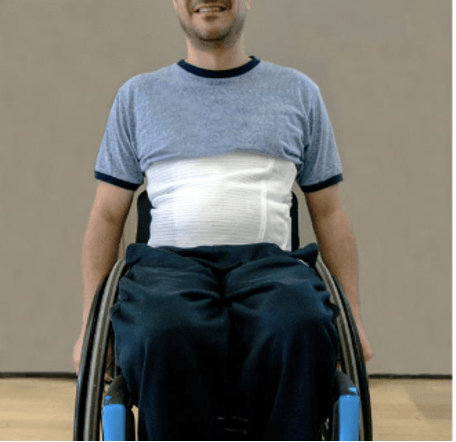Girdle/Abdominal Binder
Abdominal binders are elastic/girdle type garments that are placed around the lower torso. They should be tight enough to provide support but not be uncomfortable. Abdominal binders are used mainly to improve breathing and circulation, help maintain balance and stability of the trunk, and to support sagging of the abdomen that can happen when abdominal muscles are weak (sometimes called ‘quad belly’). Abdominal binders are mostly used in people with loss of abdominal wall strength (generally lesions above T6). Some early work (primarily level 4 studies) looking at the effects of abdominal binders on respiratory function in SCI was done prior to 1980 but was not included in this review. Studies on the effects of abdominal binders need to include positioning information as position greatly influences lung volumes in tetraplegia.
In addition to being used as a respiratory intervention, abdominal binders are used as an intervention in people with postural hypotension (see the Orthostatic Hypotension chapter).

Abdominal binders wrap around to support the abdomen when the abdominal muscles are weak or paralyzed. They are normally worn under the shirt.
Discussion
Studies demonstrate that abdominal binders in people with tetraplegia significantly increase IC or VC, and decrease FRC in all positions (McCool et al. 1986; Estenne et al. 1998; Hart et al. 2005; Prigent et al. 2010; Julia et al. 2011; West et al. 2012; Wadsworth et al. 2012). Wadsworth et al. (2012) showed that long-term use of AB significantly improved spirometry and inspiratory muscle strength. AB can improve PEFR (Wadsworth et al. 2012; West et al. 2012; Julia et al. 2011) but whether it can enhance or assist cough has been questioned (Estenne et al. 1998). Worthy of further study, the increase of diaphragmatic pressure-time product after AB may represent enhanced diaphragmatic force production, but it is not known if this change translates to an improved efficiency of breathing and decreased work of breathing.
Interventions to increase abdominal pressure and decrease the laxity of abdominal chest wall, which in turn affects diaphragm length and position, have been used in other patient groups. AB for people with SCI should be introduced cautiously and be rigorously assessed because of the potential for alteration of diaphragm length to result in mechanical inefficiency, increased dyspnea, and inspiratory muscle fatigue. The design of the abdominal binder may influence the impact of the abdominal binder (Julia et al. 2011).
One study has shown intermediate or long-term effects of AB on people with SCI (C4-T1). Positioning and using other interventions that increase abdominal pressure in other chronic respiratory conditions improve diaphragm force production but also can induce diaphragm fatigue and have variable influence on dyspnea reduction. The clinical outcomes of AB should be carefully evaluated for each person. AB could potentially have positive or deleterious effects on inspiratory muscle efficiency and dyspnea in different people after SCI.
Conclusion
There is level 2 evidence (Wadsworth et al. 2012; Cornwell et al. 2014) that AB in people with tetraplegia can improve respiratory function, and longer term use can continue to be effective.
